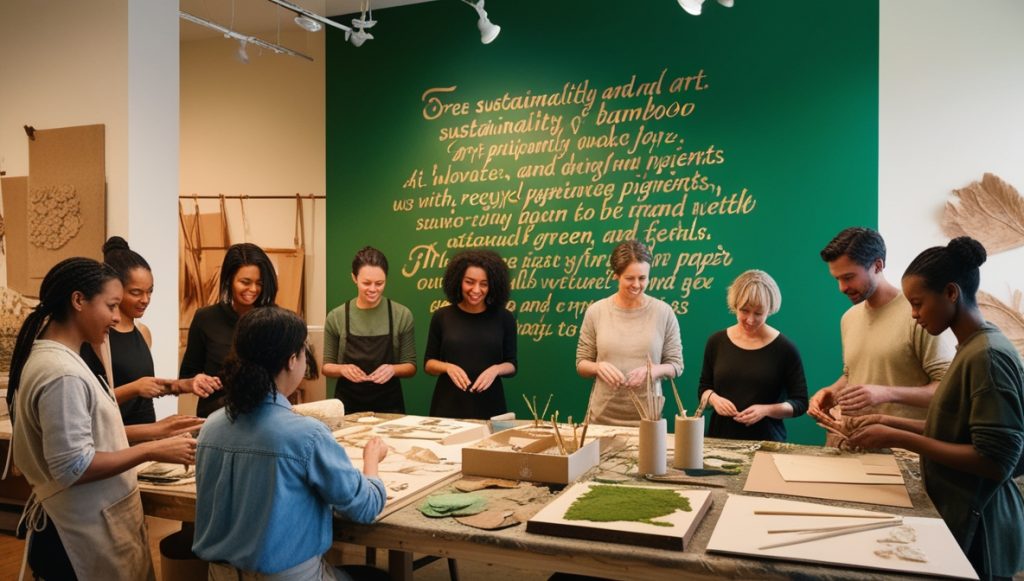As concerns about climate change and environmental degradation grow, sustainability has become a central issue in many aspects of society, including the art world. Artists are increasingly turning to eco-friendly materials and sustainable practices to create works that not only minimize their environmental impact but also raise awareness about ecological issues. By using recycled, biodegradable, and ethically sourced materials, artists are finding innovative ways to align their creative processes with environmental values while pushing the boundaries of art itself.
The Rise of Sustainable Art Practices
Sustainable art is a growing movement that seeks to reduce the environmental footprint of artistic production. Traditionally, many art materials, such as oil paints, solvents, and synthetic canvases, are made from harmful chemicals or non-renewable resources that contribute to pollution and waste. In response, contemporary artists are shifting towards eco-conscious alternatives that lessen their environmental impact without sacrificing quality or creativity.
This shift reflects a broader cultural movement toward sustainability in all aspects of life. As people become more aware of the environmental costs of consumerism, artists are embracing their role as both creators and activists. By using sustainable materials, artists not only reduce their personal carbon footprint but also contribute to a larger conversation about how we can live more harmoniously with the environment.
Recycled and Upcycled Materials
One of the most popular approaches to sustainable art is the use of recycled or upcycled materials. Rather than relying on new, mass-produced supplies, many artists choose to work with discarded or repurposed objects, transforming waste into art. This approach not only diverts materials from landfills but also encourages viewers to rethink their relationship with waste and consumption.
For example, British artist Tom Deininger is known for his large-scale sculptures and installations made entirely from found objects, such as plastic bottles, old toys, and other discarded items. By repurposing these materials, Deininger critiques consumer culture while creating visually stunning works that carry a deeper ecological message. Similarly, Brazilian artist Vik Muniz uses everyday trash to create intricate and detailed portraits, emphasizing the hidden value in what society often discards.
Upcycled art serves as a powerful reminder that waste can be reimagined as a resource, challenging the throwaway culture that contributes to environmental harm. These works encourage viewers to consider how they, too, can reduce waste and make more sustainable choices in their everyday lives.
Biodegradable and Natural Materials
In addition to recycling and upcycling, many artists are opting to use biodegradable and natural materials in their work. These materials, such as clay, wood, organic fibers, and plant-based dyes, break down naturally over time, leaving little to no harmful trace on the environment. This approach is particularly appealing to artists who seek to create ephemeral or temporary works that reflect the cycles of nature.
Land artists, such as Andy Goldsworthy, have pioneered the use of natural materials in art, often working directly with the environment to create installations that blend into or complement the landscape. Goldsworthy’s works, which include sculptures made from leaves, rocks, ice, and twigs, are designed to change and deteriorate over time, emphasizing the transient nature of life and the importance of living in balance with the earth. These creations encourage a deeper connection with nature and a recognition of its impermanence.
Additionally, artists like Aurora Robson, who creates intricate sculptures from plastic waste, incorporate biodegradable components like natural adhesives and non-toxic paints. This method not only reduces the immediate environmental impact of creating art but also ensures that the artwork does not contribute to pollution or waste once it has served its purpose.
Ethically Sourced and Renewable Materials
Another key aspect of sustainable art is the use of ethically sourced and renewable materials. This includes materials that are harvested responsibly, without harming ecosystems or depleting natural resources. For instance, many artists now use sustainably sourced wood, bamboo, or organic cotton in their work, ensuring that their materials come from renewable sources and are produced in environmentally friendly ways.
Artists like Emily Carrico focus on using sustainably sourced paper and textiles, often working with local producers to ensure that their materials are harvested in a way that respects both the environment and the communities involved in production. This attention to the ethical origins of materials helps to foster a more sustainable art practice that considers the entire lifecycle of an artwork, from creation to disposal.
Renewable materials like hemp, bamboo, and flax are gaining popularity in sustainable art as well. These fast-growing, renewable resources require minimal water and pesticides, making them more environmentally friendly alternatives to conventional materials. Artists who use these materials are not only reducing their environmental impact but also supporting the development of a more sustainable supply chain for art materials.
Raising Awareness Through Art
Beyond the materials they use, many sustainable artists see their work as a platform for raising awareness about environmental issues. By incorporating eco-friendly materials and sustainable practices into their creations, artists can challenge viewers to rethink their own impact on the environment. These works often inspire dialogue about topics such as climate change, deforestation, pollution, and the importance of conservation.
Artists like Olafur Eliasson use art to highlight urgent environmental concerns. His large-scale installations often address issues like global warming and the melting of polar ice caps. In his installation Ice Watch, Eliasson transported massive blocks of melting glacier ice to city squares, allowing the public to witness firsthand the effects of climate change. These works create an immersive experience, encouraging viewers to confront the realities of environmental degradation in a direct and emotional way.
By using sustainable materials and focusing on ecological themes, artists are playing a critical role in the global movement towards environmental responsibility. They are not only minimizing their own ecological footprints but also inspiring others to reflect on their relationship with the planet. Through sustainable art, artists continue to push boundaries, merging creativity with activism to create a more conscious and sustainable future.



